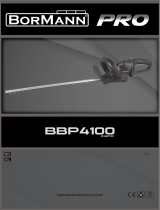
11
ENGLISH
(Original instructions)
Note: No alignment of blade with drive pin is required and
operation of the blade cover release button is not required
when re-tting the blade cover.
Use
Warning! Let the tool work at its own pace. Do not overload.
Charging the battery
The battery needs to be charged before rst use and
whenever it fails to produce sufcient power on jobs that were
easily done before. When charging the battery for the rst
time, or after prolonged storage, it will only accept an 80%
charge. After several charge and discharge cycles, the battery
will attain full capacity. The battery may become warm while
charging; this is normal and does not indicate a problem.
Warning! Do not charge the battery at ambient temperatures
below 10 °C or above 40 °C. Recommended charging
temperature: approx. 24 °C.
The tool can be left connected to the charger indenitely.
To maximise the lifetime of the battery, it is recommended to
keep the battery connected to the charger whenever the tool
is not in use. When the battery is full, the power consumption
of the charger is negligible.
Charging with the wall mount (g. F)
u Place the tool on the wall mount (11).
u Plug in the charger.
Charging with the charger plug (g. G)
The charger plug is designed with lock outs to prevent the use
of an incorrect charger.
u Insert the charger plug (12) into the charger connector at
the rear of the tool.
u Plug in the charger.
GSL700 - Charging the battery
u Charge the battery.
When the battery is charging the charging indicator (6)
ashes. The charging indicator will stop ashing when the
charging is complete.
GSL200/GSL300/GSL360 - Charging the battery
u Charge the battery.
When the battery is charging the charging indicator (6)
ashes. The charging indicator will stop ashing when the
charging is complete. The charging indicator ashes quickly
to indicate a charging problem. When a charging problem
occurs, connect the tool directly to the charger plug by
removing the wall mount. If the charging problem still occurs,
the charger must be disconnected from the mains supply and
taken to an authorised service centre for repair.
Switching on and off (g. H)
Switching on
u Push and hold the lock button (2) to the right or to the left
and then squeeze the on/off switch (1).
u Release the lock-off button.
Switching off
u Release the on/off switch (1).
Warning! Never attempt to lock the switch in the on position.
Hints for optimum use (g. I & J)
u Spray the blade with a light coating of light general use oil
before first use and whenever the blades begin to look dry.
Trimming grass
u In order to achieve optimum cutting results, only cut dry
grass.
u Hold the tool as shown in fig. I. Keep your other hand well
away from the blade. Maintain a stable working position so
that you do not slip. Do not overreach.
u When cutting long grass, work in stages from the top.
Take small cuts.
u Keep the tool away from hard objects and delicate plants.
u If the tool starts running slowly, reduce the load.
u To make a closer cut, slightly tilt the tool.
Trimming hedges
u Slightly tilt the tool (up to 15° relative to the line of cut) so
that the blade tips point slightly towards the hedge (fig. J).
This will cause the blades to cut more effectively.
u Start by trimming the top of the hedge. Hold the tool at the
desired angle and move it steadily along the line of cut.
The double-sided blade allows you to cut in either
direction.
u In order to obtain a very straight cut, stretch a piece of
string along the length of the hedge at the desired height.
Use the string as a guideline, cutting just above it.
u In order to obtain flat sides, cut upwards with the growth.
Younger stems move outwards when the blade cuts
downwards, causing shallow patches in the hedge.
u Take care to avoid any foreign objects. Especially avoid
hard objects such as metal wire and railings, as these
could damage the blades.
u Regularly oil the blades.
Guidelines for trimming (UK & Ireland)
u Trim hedges and shrubs with seasonal leaves (new leaves
every year) in June and October.
u Trim evergreens in April and August.
u Trim conifers and other fast growing shrubs every six
weeks from May until October.





















